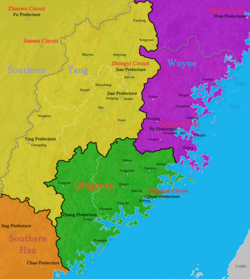Qingyuan Circuit Pinghai Circuit 清源軍 平海軍 | |||||||||
|---|---|---|---|---|---|---|---|---|---|
| 949–978 | |||||||||
 Situation of Fujian in 957 | |||||||||
| Status | De facto independent entity De jure Fanzhen of Southern Tang (949 - 975) De jure Fanzhen of Northern Song (960 - 978) | ||||||||
| Capital | Quan Prefecture (Quanzhou) | ||||||||
| Common languages | Middle Chinese Medieval Min Chinese | ||||||||
| Jiedushi | |||||||||
• 949 - 962 | Liu Congxiao (Prince of Jinjiang) | ||||||||
• 962 | Liu Shaozi (Liuhou, namely acting Jiedushi) | ||||||||
• 962 - 963 | Zhang Hansi (Liuhou) | ||||||||
• 963 - 978 | Chen Hongjin | ||||||||
| Historical era | Five Dynasties and Ten Kingdoms period | ||||||||
• Quan Prefecture gained de facto independence from Southern Tang | 947 | ||||||||
• Liu Congxiao controlled all of South Fujian | 949 | ||||||||
• Southern Tang established Qingyuan Circuit | December 949 or January 950 | ||||||||
• Northern Song established Pinghai Circuit | 9 March 964 | ||||||||
• Chen Hongjin surrendered to Northern Song | 3 June 978 | ||||||||
| Area | |||||||||
• Total | 36,000 km2 (14,000 sq mi) | ||||||||
| Population | |||||||||
• 978 estimate | 800,000[1] | ||||||||
| Currency | Tangguo Tongbao Kaiyuan Tongbao Zhouyuan Tongbao | ||||||||
| |||||||||
| Today part of | |||||||||
Qingyuan Circuit (Chinese: 清源軍) was a de facto independent entity and circuit late in China's Five Dynasties and Ten Kingdoms Period, renamed to Pinghai Circuit (平海軍) in 964. It was an office created in 949 by Southern Tang's second emperor Li Jing for the warlord Liu Congxiao, who nominally submitted to him but virtually controlled Quan Prefecture (泉州, comprising modern Quanzhou, Xiamen and Putian) and Zhang Prefecture (漳州, comprising modern Zhangzhou, Xinluo and Zhangping). Prefectures in de facto independence from the Southern Tang state.[2] (Zhang Prefecture was, at times during the circuit's existence, also known as Nan Prefecture (南州).[3] Starting in 960, in addition to being nominally submissive to Southern Tang, the Qingyuan Circuit was also nominally submissive to the Song, which had itself become Southern Tang's nominal suzerain.[4]
After demise of Congxiao, the circuit was briefly ruled by his biological nephew/adoptive son Liu Shaozi, who was then overthrown by the officers Zhang Hansi and Chen Hongjin. Zhang then ruled the circuit briefly, before Chen deposed him and took over.[3] In 978, with Song's determination to unify China proper without the pre-ceded sixteen prefectures in full order, Chen decided that he could not stay de facto independent, and offered the control of the circuit to Song's Emperor Taizong, ending the circuit as a de facto independent entity.[5]


- ^ 《福建历代人口论考》,陈景盛,福建人民出版社,1991年8月
- ^ Zizhi Tongjian, vol. 288.
- ^ a b History of Song, vol. 483.
- ^ Xu Zizhi Tongjian, vol. 1.
- ^ Xu Zizhi Tongjian, vol. 9.